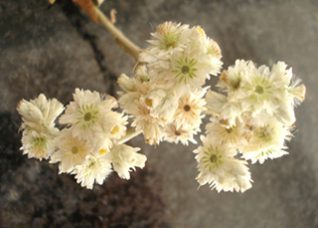
MinerAlert

MinerAlert
Pseudognaphalium obtusifolium
Asteraceae
Cudweed, cotton grass, rabbit tobacco, white cudweed
Gordolobo*, chichic tzompotonic, lobito, manzanilla del campo, manzanilla del río, papaconi, tlacochichic, tzompotonic.
*In various parts of Mexico, at least 12 related species of plants belonging to the Gnaphalium or Pseudognaphalium genera are also known by the common name of “gordolobo” (White, 2002).

This plant grows throughout Northern Mexico and parts of the Southwestern United States (Allred and Ivey, 2012).
The stem, leaves, and flowers.
The stem and flowers are decocted in water to make a tea. Sometimes, the decoctions are also applied topically as a wash for various skin problems.
The principal medicinal use of various species of gordolobo is for respiratory ailments including asthma, and bronchitis (Rodríguez-Ramos and Navarrete, 2009). The tea is also taken for colds, catarrh, fever, coughs, laryngitis, sore throat, sinusitis, pneumonia, emphysema. It is also antiseptic and antiviral. The decoction of the plant is applied topically to hemorrhoids as an anti-inflammatory. Everlasting tea promotes venous circulation and treats varicose veins, as well as gastrointestinal problems. Externally it acts as a muscle relaxant, as well as a wash for boils and skin infections. The tea is ingested to treat edemas (swelling) due to heart failure. The decoction is also applied for ear problems (Jiménez, 2012; Quattrocchi, 2012; Mendoza-Castelán and Lugo-Pérez, 2012; Chávez-Castañeda et al., 2003; Argueta, 1994).
In Chile, the leaves and stems of 3 related South American species, G. glandulosum, G. lacteum, and G. vira vira, are taken as a tea to treat coughs, bronchial, and pulmonary problems (Quattrocchi, 2012; Duke et al., 2009).
Certain plants belonging to the genera Gnaphalium and Senecio are included in the same botanical family (Asteraceae) and commonly known in Spanish as gordolobo (Schoenhals, 1988). However, these species contain very toxic and possibly carcinogenic compounds known as pyrrolizidine alkaloids that are directly toxic to the liver of humans and animals (Stillman et al., 1977).
Safety/Precautions:
Before you decide to take any medicinal herb or herbal supplement, be sure to consult with your health care professional first. Avoid self-diagnosis and self-medication: Always be on the safe side!